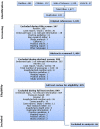Population-based incidence of all-cause anaphylaxis and its development over time: a systematic review and meta-analysis
- PMID: 38148907
- PMCID: PMC10749935
- DOI: 10.3389/falgy.2023.1249280
Population-based incidence of all-cause anaphylaxis and its development over time: a systematic review and meta-analysis
Abstract
Introduction: It is extremely difficult to compare studies investigating the frequency of anaphylaxis making it challenging to satisfactorily assess the worldwide incidence rate. Using a systematic review and meta-analysis, this publication aims to determine the current incidence of all-cause anaphylaxis worldwide. Additionally, we investigated whether the incidence of anaphylaxis has changed over time and which factors influence the rates determined by individual studies.
Methods: A literature search was performed in four databases. All articles that reported relevant information on population-based incidence rates of all-cause anaphylaxis were included. The protocol was published on INPLASY, the International Platform of Registered Systematic Review and Meta-analysis Protocols.
Results: The database query and screening process resulted in 46 eligible articles on anaphylaxis. The current incidence worldwide was found to be approximately 46 cases per 100,000 population per year (95% CI 21-103). Evaluating confounding factors showed that studies using allergy clinics and hospitalizations as data source result in comparably low rates. Moreover, children are less prone to develop anaphylaxis compared to the general population. Using a random effects Poisson model we calculated a yearly increase of anaphylaxis incidence by 7.4% (95% CI 7.3-7.6, p < 0.05).
Discussion: This seems to be the first approach to analyze every reported all-cause anaphylaxis incidence rate until 2017 for an at most accurate determination of its epidemiology. Based on these results, future research could investigate the underlying causes for the rising incidence in order find ways to decrease the condition's frequency.
Systematic review registration: inplasy.com, identifier [INPLASY202330047].
Keywords: anaphylaxis; epidemiology; incidence; meta-analysis; systematic review.
© 2023 Pühringer, Jilma and Herkner.
Conflict of interest statement
The authors declare that the research was conducted in the absence of any commercial or financial relationships that could be construed as a potential conflict of interest.
Figures


Similar articles
-
The future of Cochrane Neonatal.Early Hum Dev. 2020 Nov;150:105191. doi: 10.1016/j.earlhumdev.2020.105191. Epub 2020 Sep 12. Early Hum Dev. 2020. PMID: 33036834
-
Incidence of anaphylaxis and accidental peanut exposure: A systematic review.Clin Transl Allergy. 2021 Oct;11(8):e12064. doi: 10.1002/clt2.12064. Clin Transl Allergy. 2021. PMID: 34708943 Free PMC article. Review.
-
The international platform of registered systematic review and meta-analysis protocols (INPLASY) at 3 years: an analysis of 4,658 registered protocols on inplasy.com, platform features, and website statistics.Front Res Metr Anal. 2023 Jul 31;8:1135853. doi: 10.3389/frma.2023.1135853. eCollection 2023. Front Res Metr Anal. 2023. PMID: 37588882 Free PMC article.
-
The global incidence and prevalence of anaphylaxis in children in the general population: A systematic review.Allergy. 2019 Jun;74(6):1063-1080. doi: 10.1111/all.13732. Epub 2019 Mar 6. Allergy. 2019. PMID: 30688375
-
The Effectiveness of Early Food Introduction in Preventing Childhood Allergic Diseases: Protocol for a Systematic Review and Meta-Analysis.JMIR Res Protoc. 2023 Jun 26;12:e46816. doi: 10.2196/46816. JMIR Res Protoc. 2023. PMID: 37358892 Free PMC article.
Cited by
-
Blood Transcriptomics Identifies Multiple Gene Expression Pathways Associated with the Clinical Efficacy of Hymenoptera Venom Immunotherapy.Int J Mol Sci. 2024 Mar 20;25(6):3499. doi: 10.3390/ijms25063499. Int J Mol Sci. 2024. PMID: 38542470 Free PMC article.
-
Anaphylaxis in outpatients: A 5-year retrospective study on incidence and clinical characteristics at a university hospital in Wuhan, China.Allergy. 2025 May;80(5):1501-1505. doi: 10.1111/all.16152. Epub 2024 May 11. Allergy. 2025. PMID: 38733203 Free PMC article. No abstract available.
-
Integrated Metabolomic and Gut Microbiome Profiles Reveal Postmortem Biomarkers of Fatal Anaphylaxis.Int J Mol Sci. 2025 Jun 29;26(13):6292. doi: 10.3390/ijms26136292. Int J Mol Sci. 2025. PMID: 40650070 Free PMC article.
-
FDA approves neffy nasal spray for treatment of anaphylaxis in adult and pediatric patients.Ann Med Surg (Lond). 2025 Jun 18;87(8):4707-4709. doi: 10.1097/MS9.0000000000003510. eCollection 2025 Aug. Ann Med Surg (Lond). 2025. PMID: 40787571 Free PMC article. No abstract available.
-
Grand challenges in genetics and epidemiology of allergic diseases: from genome to exposome and back.Front Allergy. 2024 Feb 5;5:1368259. doi: 10.3389/falgy.2024.1368259. eCollection 2024. Front Allergy. 2024. PMID: 38375070 Free PMC article. No abstract available.
References
-
- Portier P, Richet CR. De l’action anaphylactique de certains venins. CR Soc Biol. (1902) 54:170–2.
-
- Sampson HA, Muñoz-Furlong A, Campbell RL, Adkinson NF, Bock SA, Branum A, et al. Second symposium on the definition and management of anaphylaxis: summary report - second national institute of allergy and infectious disease/food allergy and anaphylaxis network symposium. J Allergy Clin Immunol. (2006) 117:391–7. 10.1016/j.jaci.2005.12.1303 - DOI - PubMed
Publication types
LinkOut - more resources
Full Text Sources

